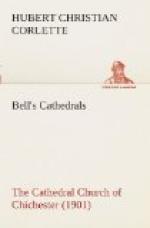The course of history that has been followed has led us through the maze of some events which served to produce the cathedral that stands among us now. The later centuries will not require as much attention, since they afford but little material, comparatively, with which we need delay; for the industry expended upon the fabric since this time has produced little change in the general appearance of the building. With the approach of the fourteenth century we meet a period when the peculiarities of the work of the thirteenth century had become merged in transitional forms, and from this application of ever-developing ideas to accepted working principles came the well-known character which English architecture displayed during that time. It was native by parentage and birth; it represented the life which prevailed in the ideas which were then the common currency. By it the ideals of thought and imagination were expressed, until, later, they were represented in other forms of art. At Chichester an early indication of the changed treatment of older methods that was being developed experimentally is shown by the portion which was added to the lady-chapel during the episcopate of Gilbert de Sancto Leophardo. The architects and master-builders devised for him the two new eastern bays complete, together with the larger windows that were inserted in the walls of that part of the chapel already built. Here again, as in the work set in motion by his successor, the designers and builders made no attempt to add these new portions in imitation of earlier ones. Then it was Bishop Langton who, between 1305 and 1337, spent L340 “on a certain wall and windows on the south side, which he constructed from the ground upwards.” [9] This work is principally to be seen in the great south window of the transept, under which he provided for himself a “founder’s” tomb. In the gable above a rose window was inserted, following the example of that earlier one in the east end of the presbytery. The chapter-house above the treasury, or sacristy, was also added when the new windows were inserted in the lower walls. About the same time the doorway to the nave within the western porch was constructed.
[9] Bishop Reade’s Register.
[Illustration: THE SOUTH TRANSEPT, ABOUT 1836. From Winkle’s Cathedral Churches.]
Walcott shows by his study of the early statutes of the cathedral that “in 1359 the first fruits of the prebendal stalls were granted to the fabric; and in 1391, one-twentieth of all their rents was allotted by the dean and chapter to the works, which embraced works round the high altar, for, in 1402, materials ‘ad opus summi altaris,’ were stored in S. Faith’s Chapel. A ‘novum opus,’ a term applied to some special building, was also in progress.” [10] These remarks are of interest, since about the end of the fourteenth century a beautiful wooden reredos was built across the east end of the sanctuary. It was placed just west of the feretory




